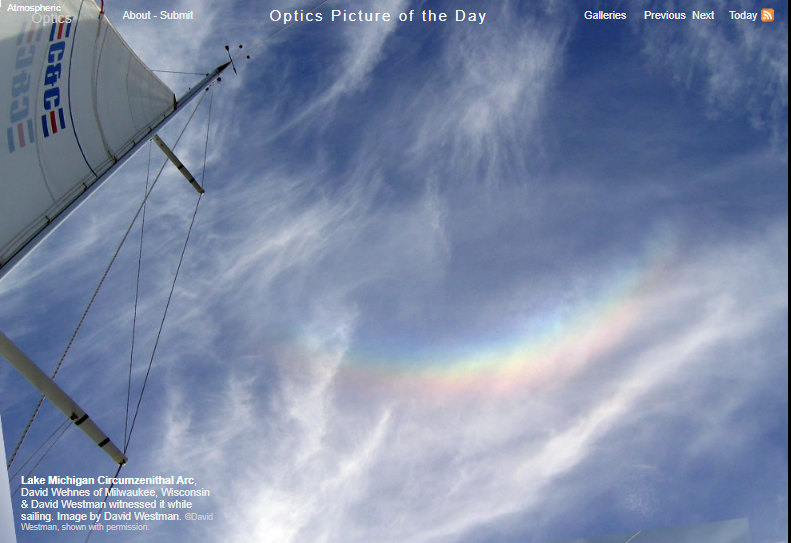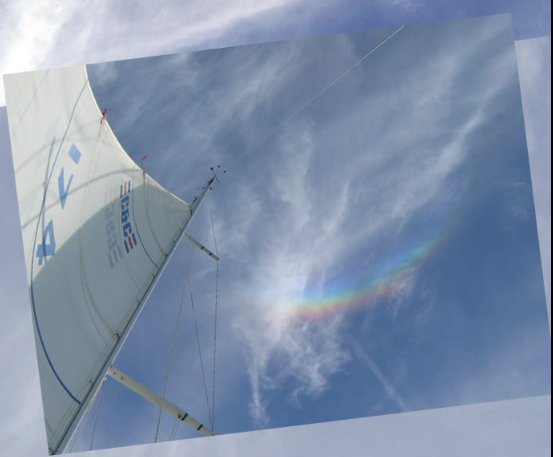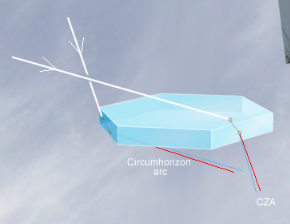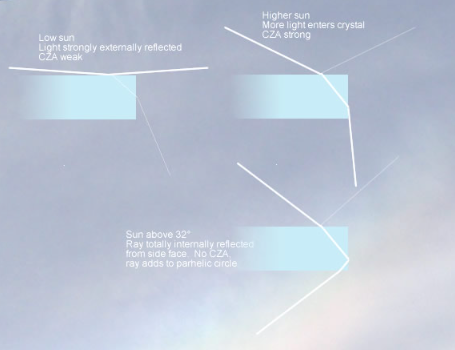CZA
The Circumzenithal Arc (CZA): A Spectacular Atmospheric Phenomenon
Have you ever looked up at the sky and witnessed a breathtaking display of colors and arcs? One such captivating phenomenon is the Circumzenithal Arc (CZA). This beautiful halo arc, often overlooked, circles the zenith and is most commonly observed when the sun is at a compromise solar elevation of around 15 to 25 degrees.
The CZA owes its existence to the refraction of sunlight through plate crystals in the atmosphere. As the sun's rays enter the upper face of these crystals, which are nearly horizontal, they exit through one of the six near-vertical side faces. This refraction process determines the unique geometry of the CZA.
One interesting feature of the CZA is its proximity to the zenith. The farthest the arc can stray from directly overhead is when the sun is very low, resulting in an offset of over 30 degrees. However, during such instances, the CZA appears faint due to two primary reasons. Firstly, the minute cross-section of the crystal face limits the amount of sunlight that interacts with it. Secondly, most rays are externally reflected at these grazing angles of incidence, further diminishing the brightness of the arc.
Despite its relative rarity and faint appearance when the sun is low, the CZA can be an awe-inspiring sight to behold. Its vibrant colors and distinct shape make it a true spectacle. The best conditions for observing a vivid CZA occur when the solar elevation is between 15 and 25 degrees, striking a balance between brightness and proximity to the zenith.
To fully appreciate the beauty of the CZA, it is essential to understand its relationship with other atmospheric phenomena. One such related phenomenon is the circumhorizon arc, which also circles the zenith. Both arcs share a common origin and are formed by the same plate crystals in the atmosphere. However, the circumhorizon arc is more often observed than the CZA, possibly due to its lower position in the sky.
Interestingly, the CZA is often unnoticed or underappreciated. Its position high overhead, coupled with its relatively rare occurrence, means that many skygazers may miss out on this stunning spectacle. However, when it does make an appearance, it is sure to captivate those fortunate enough to witness it.
In conclusion, the Circumzenithal Arc (CZA) is a remarkable atmospheric phenomenon that showcases the beauty and complexity of nature. Its origin through refraction and interaction with plate crystals results in a unique geometry that allows it to circle the zenith. While the CZA may be faint when the sun is low, it shines brightest at a compromise solar elevation of 15 to 25 degrees. So, next time you find yourself gazing at the sky, remember to keep an eye out for this mesmerizing arc that often goes unnoticed but deserves our utmost appreciation.


Lake Michigan Circumzenithal Arc, David Wehnes of Milwaukee, Wisconsin & David Westman witnessed it while sailing. Image by David Westman. ©David Westman, shown with permission.
The mast nicely shows that this most beautiful of the halo arcs does indeed (partially at least, see the Kern arc) circle the zenith (so does the related circumhorizon arc!) and is sufficiently far overhead that it is noticed less often than it deserves.
The CZA's origin via refraction through plate crystals determines its geometry. The sun's rays enter a near horizontal upper face and leave through one of the six near vertical side faces.
The farthest the arc can stray from the zenith is when the sun is very low. The CZA can then be over 30 degrees from directly overhead.
But then it is very faint: (1) because the crystal face subtends only a minute cross-section to the incoming rays and (2) most rays are externally reflected at these grazing angles of incidence.
The brightest CZAs are at a compromise solar elevation, some 15 to 25 degrees.


Note: this article has been automatically converted from the old site and may not appear as intended. You can find the original article here.
Reference Atmospheric Optics
If you use any of the definitions, information, or data presented on Atmospheric Optics, please copy the link or reference below to properly credit us as the reference source. Thank you!
-
<a href="https://atoptics.co.uk/blog/cza/">CZA</a>
-
"CZA". Atmospheric Optics. Accessed on November 26, 2024. https://atoptics.co.uk/blog/cza/.
-
"CZA". Atmospheric Optics, https://atoptics.co.uk/blog/cza/. Accessed 26 November, 2024
-
CZA. Atmospheric Optics. Retrieved from https://atoptics.co.uk/blog/cza/.